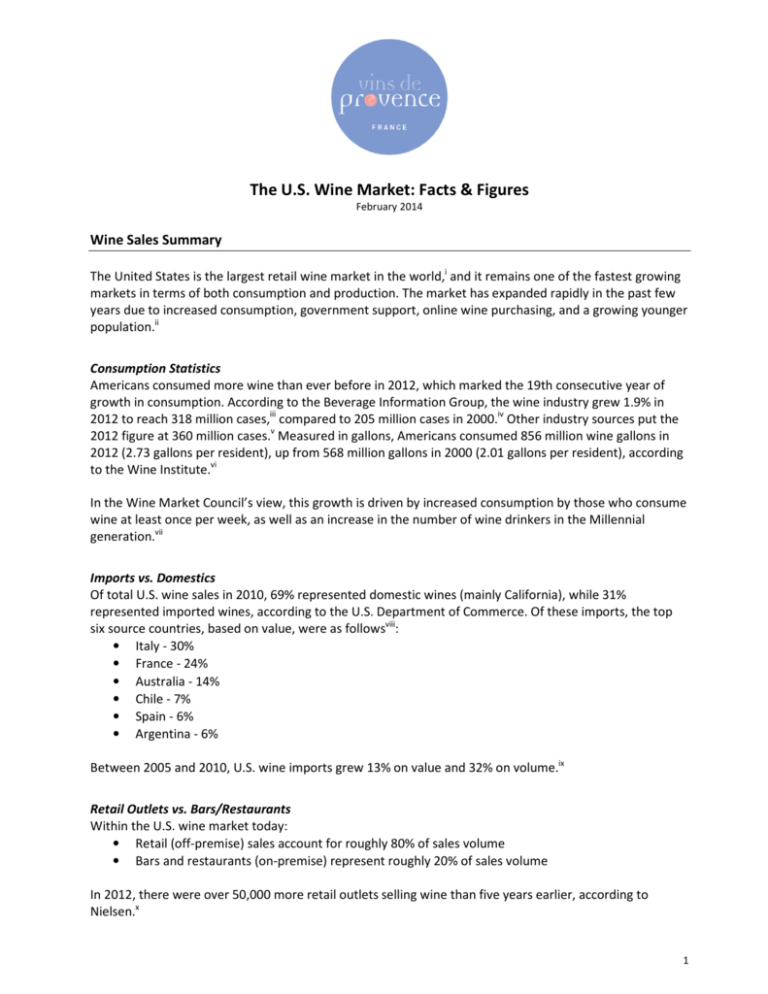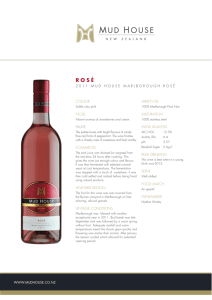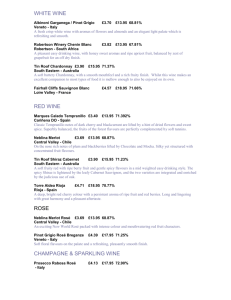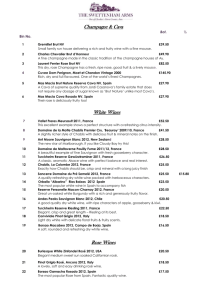The US Wine Market: Facts & Figures
advertisement

The U.S. Wine Market: Facts & Figures February 2014 Wine Sales Summary The United States is the largest retail wine market in the world,i and it remains one of the fastest growing markets in terms of both consumption and production. The market has expanded rapidly in the past few years due to increased consumption, government support, online wine purchasing, and a growing younger population.ii Consumption Statistics Americans consumed more wine than ever before in 2012, which marked the 19th consecutive year of growth in consumption. According to the Beverage Information Group, the wine industry grew 1.9% in 2012 to reach 318 million cases,iii compared to 205 million cases in 2000.iv Other industry sources put the 2012 figure at 360 million cases.v Measured in gallons, Americans consumed 856 million wine gallons in 2012 (2.73 gallons per resident), up from 568 million gallons in 2000 (2.01 gallons per resident), according to the Wine Institute.vi In the Wine Market Council’s view, this growth is driven by increased consumption by those who consume wine at least once per week, as well as an increase in the number of wine drinkers in the Millennial generation.vii Imports vs. Domestics Of total U.S. wine sales in 2010, 69% represented domestic wines (mainly California), while 31% represented imported wines, according to the U.S. Department of Commerce. Of these imports, the top six source countries, based on value, were as followsviii: • Italy - 30% • France - 24% • Australia - 14% • Chile - 7% • Spain - 6% • Argentina - 6% Between 2005 and 2010, U.S. wine imports grew 13% on value and 32% on volume.ix Retail Outlets vs. Bars/Restaurants Within the U.S. wine market today: • Retail (off-premise) sales account for roughly 80% of sales volume • Bars and restaurants (on-premise) represent roughly 20% of sales volume In 2012, there were over 50,000 more retail outlets selling wine than five years earlier, according to Nielsen.x 1 Growth of Rosé in the U.S. In 2010, retail category sales in the U.S. broke out as follows: 47% red wines, 40% white wines, and 13% blush (pink) wines.xi Traditionally, the U.S. wine industry has grouped dry rosé wines together with sweet blush wines. This method of categorization perpetuates the misperception that rosé is the same as blush. Yet, this mistaken notion appears to be on the decline as dry rosé grows in popularity. Nielsen reported in January 2013 and January 2014 that blush wine sales volumes fell in both previous years (-3.9% in 2012 and -2.9% in 2013), while premium rosé sales, imported and domestic, were up (33.6% in 2012 and 39.8% in 2013).xii Growth rates for imported rosés have been well ahead of the market in the U.S. for at least nine years – as long as Nielsen has been tracking this as a separate segment at retail. Retail sales of premium imported rosé wine (those priced at or above $12 a bottle) grew by 48% on dollars and 39% on volume in 2013. By comparison, total table wine sales grew by 4.5% on dollars and 1.2% on volume.xiii In addition, the average price per bottle in the premium rosé segment increased to $16.38 in 2013, a dollar more than in 2012. In terms of global rosé consumption, the U.S. is second after France, where rosé outsells white wine. The U.S. is responsible for 13% of all rosé wine consumed worldwide. As in many countries, women in the U.S. consume more rosé than men (55% vs. 45%). Within the U.S., metro New York accounts for nearly 20% of all rosé imported, and Miami accounts for 15%.xiv Projections show the rosé growth trend continuing. In a May 2012 article on the global rosé wine trend, the Revue Vinicole Internationale (International Wine Review) referenced industry experts who “agree that dry rose will represent 15%” of the U.S. market in 2015.xv The reasons for rosé’s growing popularity likely include the rise of younger, more adventurous wine consumers, an appealing color, an attractive price point, and an accessible flavor profile.xvi Provence Rosé: The Benchmark Provence is the world’s largest wine region specializing in AOP rosé wine. It is also the site of France’s oldest vineyards, with a 2,600-year history of rosé winemaking. Provence is known not only as “the locus of rosé’s spiritual soul”xvii but also as the quality leader. A 2008 market study by EOC International found that members of the U.S. wine industry – importers, distributors, retailers, sommeliers, and restaurateurs – perceive French rosé as the highest quality rosé, and rosé from Provence as the “gold standard.” Many leading wine critics concur. Provence Rosé Production Factsxviii • Approximately 10% of the world’s wine production is rosé, and France is the leading producer. • Provence produces 35% of French AOP rosés. The AOP designation, short for Appellation d’Origine Protégée, or protected area of origin, is an assurance of authenticity and quality. • More than 88% of all AOP wines produced in Provence in 2013 were rosés. Provence Rosé Export Facts • Exports of rosé wine to the U.S. from Provence jumped 40% on both volume and value from November 2012 to November 2013. This was the 10th consecutive year of double-digit increases in rosé export volumes from Provence to the U.S.xix • In New York City today, 100% of wine retailers carry at least one Provence rosé reference.xx • The U.S. market has access to more – and more diverse – Provence rosé wines than ever before. 2 For More Information Media Contacts Joan Brower/Janet Bartucci The Dilenschneider Group, Inc. th MetLife Building, 200 Park Avenue, 26 Floor New York, NY 10166 Tel: 212-922-0900; Fax: 212-922-0971 Email: media@winesofprovence.com Trade Contacts Julie Peterson/Carlene Hastings Vins de Provence – U.S. Office 1025 Thomas Jefferson St. NW Suite 420 East Washington, DC 20007 Tel: 202-499-4263 Email: trade@winesofprovence.com Web: www.winesofprovence.com i U.S. Department of Commerce, “U.S. Wine Industry – 2011,” http://www.ita.doc.gov/td/ocg/wine2011.pdf Research and Markets, “US Wine Market Forecast to 2012,” April 2010, http://www.researchandmarkets.com/reports/648785/us_wine_market_forecast_to_2012 iii Beverage Information Group, “U.S. Wine Consumption Continues to Gain Strength,” September 23, 2013, http://www.albevresearch.com/ME2/Audiences/dirmod.asp?sid=&nm=&type=MultiPublishing&mod=PublishingTitles&mid=6EECC0FE471F4CA99 5CE2A3E9A8E4207&tier=4&id=897B187A5EFA4B6CA9FAFBF02CACF1C1&AudID=02CB92983A7B42B2A36A3A6F893A6EEC iv WineBusiness.com, “U.S. Wine Consumer Trends: Boomers' Tastes Evolve, Millennials Continue to Drive Market Growth,” January 2011, http://www.winebusiness.com/news/?go=getArticle&dataid=83196 v “Record Wine Sales in U.S.,” April 10, 2013, http://www.wine-searcher.com/m/2013/04/record-wine-sales-in-us vi Wine Institute, “Wine Consumption In The U.S.,” March 14, 2013, http://www.wineinstitute.org/resources/statistics/article86 vii Vine Talk, “US Wine Consumption Grows in 2013,” March 4, 2013, http://www.vinetalk.com/us-wine-consumption-grows-in-2012/ viii U.S. Department of Commerce, “U.S. Wine Industry – 2011,” http://www.ita.doc.gov/td/ocg/wine2011.pdf ix Ibid x Wine Institute, “2012 California and U.S. Wine Sales,” http://www.wineinstitute.org/resources/statistics/article697 xi U.S. Department of Commerce, “U.S. Wine Industry – 2011,” http://www.ita.doc.gov/td/ocg/wine2011.pdf xii Nielsen report to Wine Market Council, January 2013 and January 2014 xiii Nielsen report to CIVP/Provence Wine Council, January 2014 xiv Revue Vinicole Internationale, May 2012 xv Ibid xvi Wine Business Monthly, “Retail Sales Report: Rosé Trend Defines Summer 2007,” November 2007 xvii Oldman’s Brave New World of Wine, New York: W.W. Norton & Co., 2010, page 114 xviii CIVP/Provence Wine Council xix French Customs and CIVP xx CIVP ii 3






